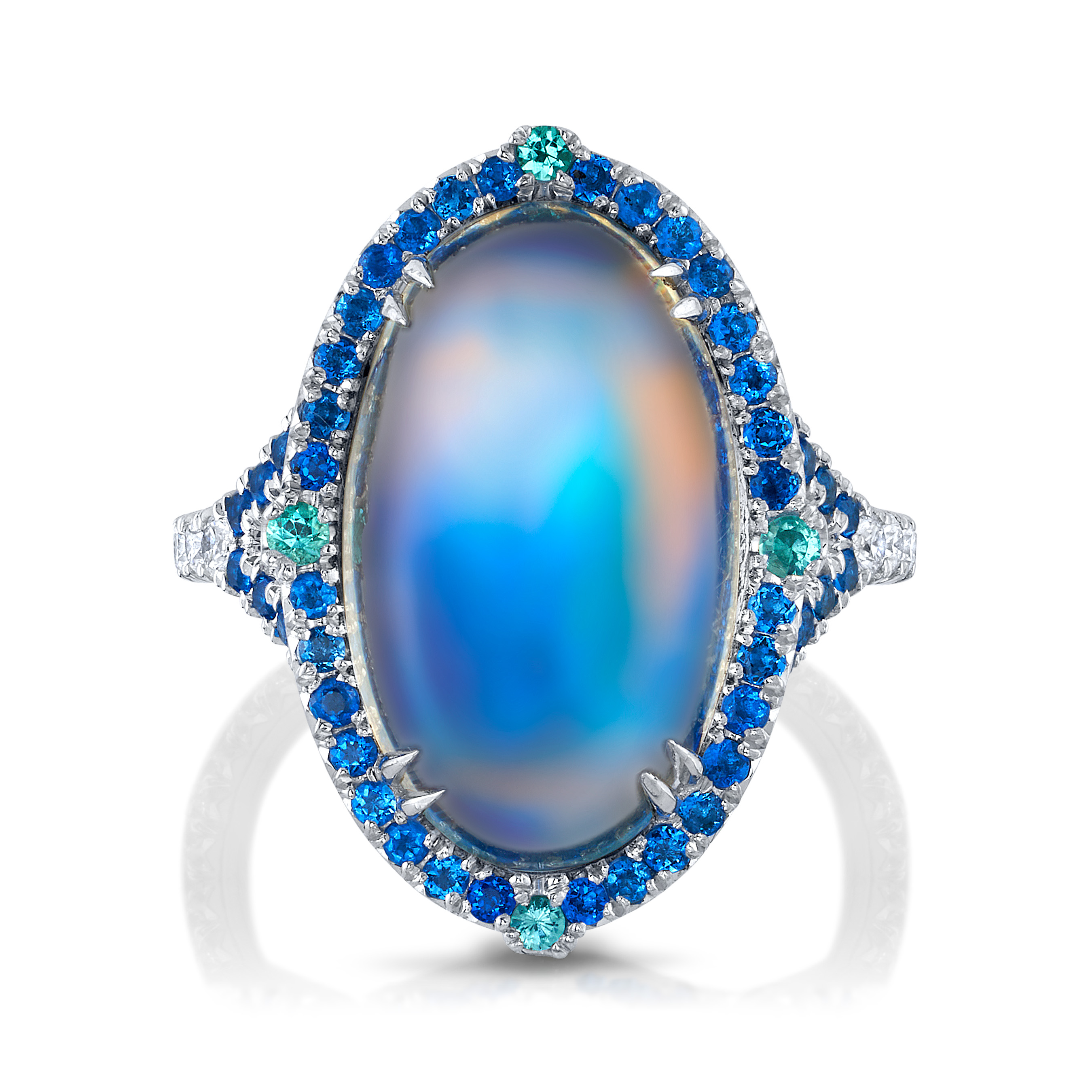
Award Winning Moonstone, Paraíba-Type Moonstone, Paraíba Tourmaline, Hauyne & Diamond Ring
Award winning platinum ring featuring a 10.64 carat oval cabochon moonstone accented by 0.07 carat total weight of round Paraíba tourmalines, 0.37 carat total weight of round hauynes and 0.22 carat total weight of round diamonds.
2024 JCK Jewelers' Choice Awards
1st Place - Platinum Jewelry
Influencers’ Award for Platinum Jewelry
Editors’ Award for Platinum Jewelry
R2696-RC1011-MSOV
Unique Design Traits
A stunning moonstone, complimented by Brazilian Paraíba tourmaline, hauyne and diamonds create a design that can be worn casually with jeans or dressed up to make a statement.
Top quality moonstones will be transparent without few if any inclusions and a clearly visible sheen. Most Moonstones tend to be included and/or semi-transparent.
Moonstone is plated in metal underneath helping to display the billowing adularescence (blue sheen/glow) of the moonstone.
The moonstones adularesence is enhanced by Brazilian Paraíba accents and hauyne halo and shank details, allowing the blue beauty to shine!
Hauyne is a rarely faceted gemstone from Germany that displays an almost electric bright blue.
Award winner of the 2024 JCK Jewelers' Choice Awards, 1st Place - Platinum Jewelry, Influencers’ Award for Platinum Jewelry and Editors’ Award for Platinum Jewelry.
Gemstone Details
Moonstone
A member of the feldspar group, orthoclase, moonstone is known for its distinct sheen under certain lighting conditions called adularescence. Its name is owed to this phenomenon, the blue sheen is said to resemble the glow of the moon. Adularescence is a result of a natural growth pattern of alternating layers of feldspar minerals, orthoclase and albite. This layering causes an interference of light as it enters the stone, reflecting back as the sheen beloved in moonstones, making them appear to glow from within.
Legends say the stone provides good luck, Hindu legend believes it was formed by moonbeams, and in Arab countries, women historically sewed moonstones into their garments to promote fertility. Properties often associated with the moon have been applied to this gemstone, such as romance, femininity, intuition, dreams and love. Long been a favored gemstone in jewelry, designers of the romantic Art Nouveau era, such as René Lalique and Louis Comfort Tiffany, heavily featured moonstone.
Like most gemstones, the most prized moonstones contain no visible inclusions; they will also have a colorless, semitransparent to nearly transparent body color with strong vivid adularescence.
Moonstone is one of the birthstones for June.
Paraíba Tourmaline
Neon blue copper-bearing tourmaline was discovered in the hills of the Brazilian state of Paraíba, in the late 1980's. Various gemological laboratories performed testing on the new material and discovered that it was a natural elbaite tourmaline. Elbaite is generally achromatic, which means the crystals are colorless unless there are trace elements present in the chemical formula. In the case of Paraíba tourmaline, the crystals contain trace amounts of copper, which give the gemstones their unique and vibrant color and the reference of cuprian, which stands for copper-bearing. This variety of tourmaline was officially named "Paraíba tourmaline" after the state in Brazil in which it was discovered.
Their rarity is unmatched, as there is only one Paraíba tourmaline mined in Brazil for every 10,000 diamonds, and a fine quality Paraíba over three carats is virtually unheard of. A point to keep in mind is that copper bearing tourmalines have been mined in Mozambique, Nigeria and other localities, however, they are referred to as Paraíba-type tourmalines, because a true Paraíba tourmaline can only come from Brazil, making it all the more rare.
Color is perhaps the most important variable when comparing these stones, all other things being equal. Inclusions are to be expected and forgiven when judging fine stones, as long as saturation of color and brightness remain strong. Nearly every other shade of tourmaline is found in Brazil, however none has the vivid glow that distinguishes the Paraíba tourmaline. Colors ranging from bright turquoise to majestic blue-green to “windex” blue, it’s the incandescent glow that appears to light up the stone from within that makes Paraíba tourmalines incomparable to any other gemstone.
Tourmaline is the birthstone for October and the gift for the eighth wedding anniversary.
Hauyne
Hauyne is an extremely rare mineral and even rarer as a faceted gemstone; first discovered in the early 19th century in southern Italy. A member of the sodalite group of minerals, it is commonly found in volcanic areas, such as among the Vesuvian lava flows on Monte Somma. It was named for the “father of crystallography,” Abbé Rene Just Haüy. Hauyne is noted for its electric blue color, although it has been found in other colors, such as white, grey, yellow, green and pink. It is also noted for its perfect cleavage and brittleness, ranked as a 5.5-6 on the Mohs scale, which makes faceting the material difficult and thus rare. It is one of the possible constituent minerals of lapis lazuli. Today the most well-known locality for hauyne is the Eifel Mountains of Germany.
Design Details
Moonstone, Paraíba Tourmaline, Hauyne & Diamond Ring
Platinum, Size 7
1 Moonstone Oval Cabochon 10.64 ct. (18.23x10.73x7.84mm) - Natural
4 Paraíba Tourmaline Round 0.07 ctw. - Heated
52 Hauyne Round 0.37 ctw. - Natural
14 Diamond Round 0.22 ctw. - (E-F/VS+)

